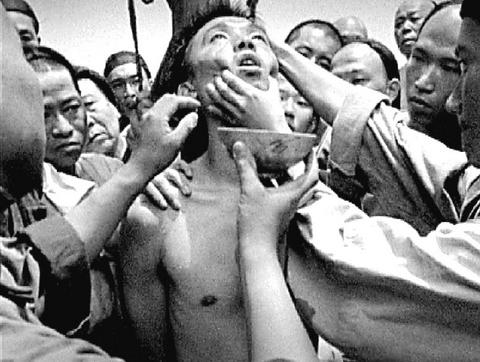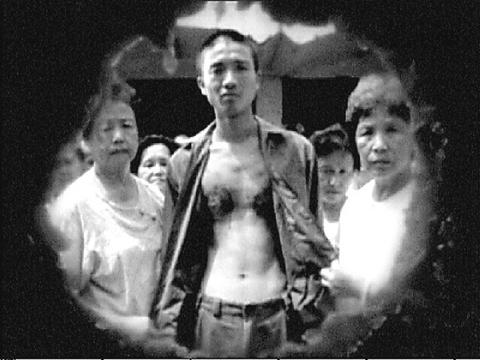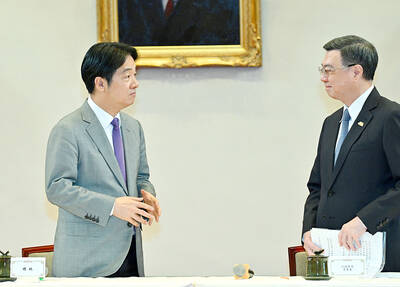The international exhibition of the Taipei Biennial: Great Theatre of the World is currently on view at the Taipei Fine Arts Museum until March 2, 2003. Using the theme of the world as a theatre allows for some reflections for the audience on how we are all actors in this game of life.
One dynamic work that stands out from the rest is the film Lingchi -- Echoes of a Historical Photograph by Taiwanese artist Chen Chieh-jen (陳界仁) who combines a fictive imagining of a real historical event with the current tragedy of local Taiwanese laborers.
Shot using 16mm film and transferred to DVD, the silent black and white movie (approximately 20 minutes long) is beamed onto large screens with three projectors, thus creating an effect that is powerful, mystical, majestic and monumental. At times all three projections are in sync, and at other times the screens show three different images.

COURTESY OF CHEN CHEH-JEH
The film is based on the famous 1905 photograph of a man being punished the Manchu way, by being cut into pieces for the crime of murder. His ecstatic expression is attributed to opium, which was administered to prolong the torture. Philosopher Georges Bataille discussed this photo extensively in his book The Tears of Eros and noted the correlations between the beauty of religious eroticism, divine ecstasy and the shocking horror of cruel torture.
Chen's cinematic close-ups of the victim's face bring to mind images of blissful euphoria, homoeroticism, and religious crucifixion. Slow motion close-ups of a hand holding a knife, the grim expressions of the crowd of ponytailed bystanders, blood dripping down the crowd's legs and flowing into the ground are eerie, but surprisingly not as violent as what one might expect considering Chen's topic. The film is oddly un-sadistic, even though the content is of death by dismemberment.
Interspliced with the staged reenactment of the torture scene are scenes where the camera slowly pans above a crowd of silent women. These women are factory workers in Taoyuan, and due to various tragic events such as occupational hazards or unemployment, they no longer are able to work. Chen links these contemporary women to the 1905 victim. Due to the women's circumstances, which are often beyond their control, they are also suffering a long torture, but without any bliss.

Chen came to international prominence with his large computer images of similar torture scenes. However, this film is a departure from those past works. By linking the historical with the contemporary social and economic situation in Taiwan, Chen has created an extremely powerful work that links the past with the present, the fictive with the documentary. He is also specific to the local situation, while remaining universal.
One irritating drawback to viewing Lingchi is the encroaching cacophony of sounds from other artists' installations, which dramatically shatters the silence of this overwhelmingly poetic work. However, this is not a reason to avoid seeing the work. It's a cinematic experience worth remembering.


Under pressure, President William Lai (賴清德) has enacted his first cabinet reshuffle. Whether it will be enough to staunch the bleeding remains to be seen. Cabinet members in the Executive Yuan almost always end up as sacrificial lambs, especially those appointed early in a president’s term. When presidents are under pressure, the cabinet is reshuffled. This is not unique to any party or president; this is the custom. This is the case in many democracies, especially parliamentary ones. In Taiwan, constitutionally the president presides over the heads of the five branches of government, each of which is confusingly translated as “president”

Sept. 1 to Sept. 7 In 1899, Kozaburo Hirai became the first documented Japanese to wed a Taiwanese under colonial rule. The soldier was partly motivated by the government’s policy of assimilating the Taiwanese population through intermarriage. While his friends and family disapproved and even mocked him, the marriage endured. By 1930, when his story appeared in Tales of Virtuous Deeds in Taiwan, Hirai had settled in his wife’s rural Changhua hometown, farming the land and integrating into local society. Similarly, Aiko Fujii, who married into the prominent Wufeng Lin Family (霧峰林家) in 1927, quickly learned Hoklo (commonly known as Taiwanese) and

The low voter turnout for the referendum on Aug. 23 shows that many Taiwanese are apathetic about nuclear energy, but there are long-term energy stakes involved that the public needs to grasp Taiwan faces an energy trilemma: soaring AI-driven demand, pressure to cut carbon and reliance on fragile fuel imports. But the nuclear referendum on Aug. 23 showed how little this registered with voters, many of whom neither see the long game nor grasp the stakes. Volunteer referendum worker Vivian Chen (陳薇安) put it bluntly: “I’ve seen many people asking what they’re voting for when they arrive to vote. They cast their vote without even doing any research.” Imagine Taiwanese voters invited to a poker table. The bet looked simple — yes or no — yet most never showed. More than two-thirds of those

In the run-up to the referendum on re-opening Pingtung County’s Ma-anshan Nuclear Power Plant last month, the media inundated us with explainers. A favorite factoid of the international media, endlessly recycled, was that Taiwan has no energy reserves for a blockade, thus necessitating re-opening the nuclear plants. As presented by the Chinese-language CommonWealth Magazine, it runs: “According to the US Department of Commerce International Trade Administration, 97.73 percent of Taiwan’s energy is imported, and estimates are that Taiwan has only 11 days of reserves available in the event of a blockade.” This factoid is not an outright lie — that